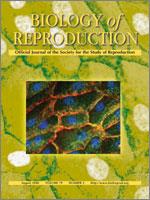Adenosine triphosphate-sensitive K (KATP) channels are poorly characterized in the reproductive tract. The present study was designed to evaluate the putative expression of KATP channel subunits (Kir6.x and SURx) in the epididymis from different mammalian species. Immunohistochemical, Western blot, and RT-PCR techniques were used. A positive immunostaining for Kir6.2 (KCNJ11) and SUR2 (ABCC9) was observed by immunoenzymatic and immunofluorescent approaches in the principal epithelial cells throughout all regions of the rat and mouse epididymis. Double labeling with anti-aquaporin 9 (AQP9) and anti-Kir6.2 (KCNJ11) confirmed their colocalization in the principal cells. No immunostaining could be demonstrated for Kir6.1 (KCNJ8) and SUR1 (ABCC8) subunits. Under higher magnification, the immunostaining for Kir6.2 (KCNJ11) exhibited a cytoplasmic labeling that was more intense at the level of the Golgi apparatus along the whole epididymis. A similar pattern was observed for SUR2 (ABCC9), although in the latter case, the Golgi labeling appeared to be region specific. Spermatozoa in epididymal tubules from rodents also immunostained for Kir6.2 (KCNJ11) and SUR2 (ABCC9). Western blot analysis of epididymal total protein and crude membrane extracts from adult and prepubertal rats confirmed the presence of Kir6.2 (KCNJ11). SUR2 (ABCC9) protein expression was detected in adult epididymal extracts. Furthermore, RT-PCR established the presence of Kir6.2 (KCNJ11) and SUR2 (ABCC9) mRNA in prepubertal and adult mouse epididymis. Indirect immunofluorescence also documented the presence of Kir6.2 (KCNJ11) and SUR2 (ABCC9) in the epididymal epithelium, as well as in spermatozoa, of canine, feline, bovine, and human origin. These data demonstrate the presence of the KATP channel subunits, Kir6.2 (KCNJ11) and SUR2 (ABCC9), in epididymal epithelial cells and spermatozoa from several mammalian species. Although their physiological roles need to be fully characterized, it is tempting to propose that such types of K channels might be involved in protein secretion and fluid-electrolyte transport occurring along the epididymal epithelium, leading to spermatozoa maturation.
How to translate text using browser tools
1 August 2008
KATP Channel Subunits Are Expressed in the Epididymal Epithelium in Several Mammalian Species
Pascale Lybaert,
Anne Marie Vanbellinghen,
Eric Quertinmont,
Michel Petein,
Sylvain Meuris,
Philippe Lebrun
ACCESS THE FULL ARTICLE

Biology of Reproduction
Vol. 79 • No. 2
August 2008
Vol. 79 • No. 2
August 2008
epididymis
male reproductive tract
potassium channels
sperm maturation




